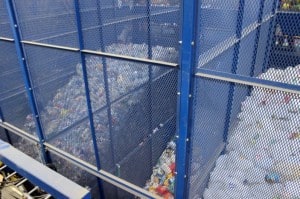
(Chelsea Update would like to thank Frank Hammer and the Western Washtenaw Recycling Authority for the information in this column.)
One way of thinking about the waste stream is to realize that we—the consumers—are at the midpoint of the life cycle of every manufactured item we use.
Think of an item’s life cycle as a clock face. The creation of the item is at 12:00, getting it to you (transportation, marketing, etc.) is between 1 and 5, your use of it is between 5 and 7, and—even though you don’t see it any more, the return of the product is the 5 hours between 7 and 12.
Reggie says that getting the waste stream where it needs to be by midnight is a lot like meeting curfew…it’s a good thing.
So, what happens during that five hours to get the item home in time?
In Chelsea, there are two paths—one is to the landfill, and one is to a market for reusing the material. The landfill path takes the items to the transfer station, located next door to WWRA on Werkner Road. Many years ago, this was the location of “the landfill,” or colloquially, “the dump,” because most of what came through was put in a big pit in the ground and covered with a layer of soil. User fees cover all costs of landfilling.

The pit eventually filled up, however, and now landfill (trash) is trucked from Chelsea’s transfer station to another facility in northeastern Washtenaw County. Once buried, this gets the trash to 12:00 – home by midnight. Over time – lots more than five hours – some landfill will biodegrade (rot). In modern landfills, facilities have been integrated to capture the methane gas this produces, and sell or burn it. But, much of the landfill material is permanent (like flexible or foamy plastics) and some of it is toxic (like random mixtures of household chemicals.) It remains forever buried, for future archeologists to discover.
Reggie wonders what they will think of our culture.
The other path is recycling, which is carried out by WWRA in this part of the county. WWRA is organized as a community service to collect, transport and sell to markets. It is paid for by the resale of the items, underwritten by taxes. Thinking about the clock, this takes from 7 to about 9 or so, when the sale takes place. Between 9 and 12, the material is re-processed into new items, by the industry that purchased it.
The markets that purchase the material are only interested in hard plastics, paper, metal and container glass. And, in each category, there are still some “no-no’s” that belong in the landfill, not recycling.
In plastics, the big ones are foamy material and flexible plastics, unless they are in massive, semi-sized quantities.
In metals, wire is problematic, but can be recycled if delivered in person.
Glass containers are fine, but not sheet glass—mirrors, window glass, etc.—and never light bulbs of any kind. These items, as well as other landfill items (e.g., construction waste, partially filled paint cans, dirty diapers … the list is extensive) are very costly for WWRA and the community, for the following reason.
A huge machine, in reality multiple machines as a system, currently manages the job of sorting all the stuff that comes in very efficiently. This machine allowed WWRA to provide the service of single stream collection, instead of asking recyclers to sort before they throw. However, the efficiency of the machine depends heavily on the amount of landfill that is mixed in to the recycle stream. When WWRA spends community money for landfill, it is a huge waste of community resources. It takes worker-time to sort it, takes a big toll on the machinery, costs WWRA fees to landfill it, and ultimately keeps us all from getting home by midnight.
Reggie doesn’t like getting in trouble for breaking curfew, and thinks you don’t, either.
Next week, Reggie will discuss items that can be recycled, but require special handling – not in the bins.
Reggie’s Royal Recycling Review: Help Reggie get home by midnight, by keeping landfill (trash) and recycling (salable materials) separate after you use them.














